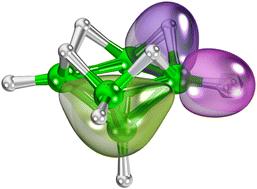当前位置:
X-MOL 学术
›
Dalton Trans.
›
论文详情
Our official English website, www.x-mol.net, welcomes your
feedback! (Note: you will need to create a separate account there.)
Heats of formation on the way from B2H6 to B20H16: thermochemical consequences of multicenter bonding in ab initio and DFT methods
Dalton Transactions ( IF 3.5 ) Pub Date : 2024-11-05 , DOI: 10.1039/d4dt02589j Jindřich Fanfrlík, Jan Řezáč, Drahomír Hnyk, Josef Holub
Dalton Transactions ( IF 3.5 ) Pub Date : 2024-11-05 , DOI: 10.1039/d4dt02589j Jindřich Fanfrlík, Jan Řezáč, Drahomír Hnyk, Josef Holub

|
The objective of this study is to evaluate the effectiveness of various computational methods in reproducing the experimental heats of formation of boron hydrides using the atomization energy approach. The results have demonstrated that the empirical dispersion combined with the BJ damping function provided too large intramolecular dispersion energies, thereby compromising the accuracy of the outcomes produced by the DFT-D3 methods. Additionally, the CCSD(T) method has reproduced the experimental values only when combined with a basis set optimized for an accurate description of the core-valence correlation effect. Furthermore, the number of multicenter bonds present in the molecules under examination has also reflected their stability, as indicated by the heats of formation. Finally, a five-center two-electron (5c–2e) bond has emerged in B5H9, by applying the intrinsic bond orbital (IBO) method.
中文翻译:

从 B2H6 到 B20H16 的形成热:从头和 DFT 方法中多中心键合的热化学后果
本研究的目的是评估各种计算方法使用原子化能方法再现氢化硼形成的实验热量的有效性。结果表明,经验色散与 BJ 阻尼函数相结合提供了过大的分子内色散能,从而损害了 DFT-D3 方法产生的结果的准确性。此外,CCSD(T) 方法只有在与为准确描述核价相关效应而优化的基集相结合时,才能重现实验值。此外,被检查分子中存在的多中心键的数量也反映了它们的稳定性,如形成热所示。最后,通过应用本征键轨道 (IBO) 方法,在 B5H9 中出现了一个五中心双电子 (5c-2e) 键。
更新日期:2024-11-05
中文翻译:

从 B2H6 到 B20H16 的形成热:从头和 DFT 方法中多中心键合的热化学后果
本研究的目的是评估各种计算方法使用原子化能方法再现氢化硼形成的实验热量的有效性。结果表明,经验色散与 BJ 阻尼函数相结合提供了过大的分子内色散能,从而损害了 DFT-D3 方法产生的结果的准确性。此外,CCSD(T) 方法只有在与为准确描述核价相关效应而优化的基集相结合时,才能重现实验值。此外,被检查分子中存在的多中心键的数量也反映了它们的稳定性,如形成热所示。最后,通过应用本征键轨道 (IBO) 方法,在 B5H9 中出现了一个五中心双电子 (5c-2e) 键。


















































 京公网安备 11010802027423号
京公网安备 11010802027423号